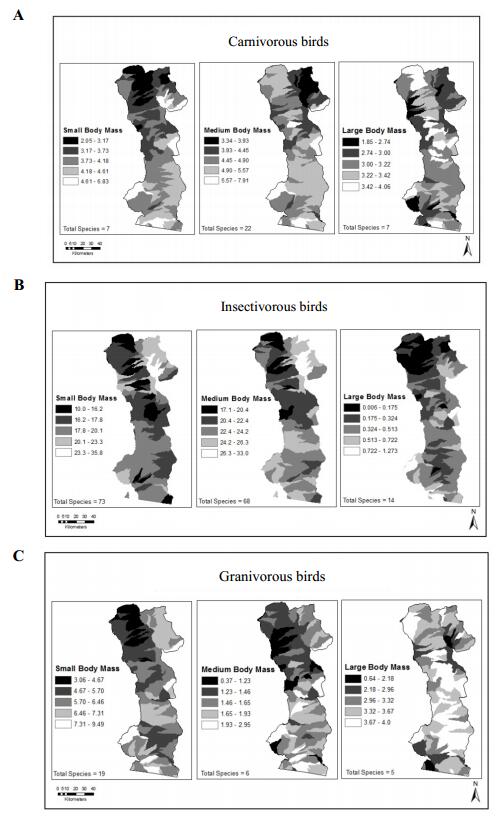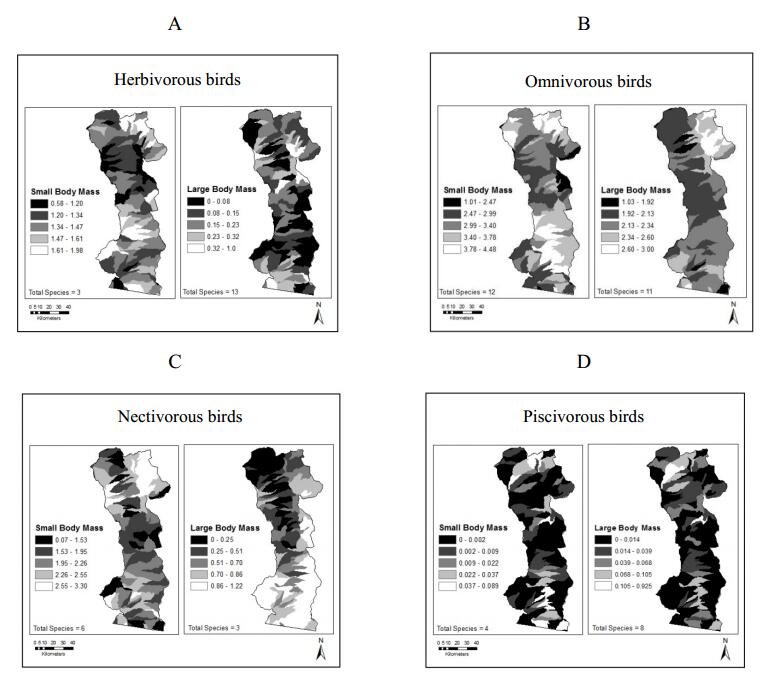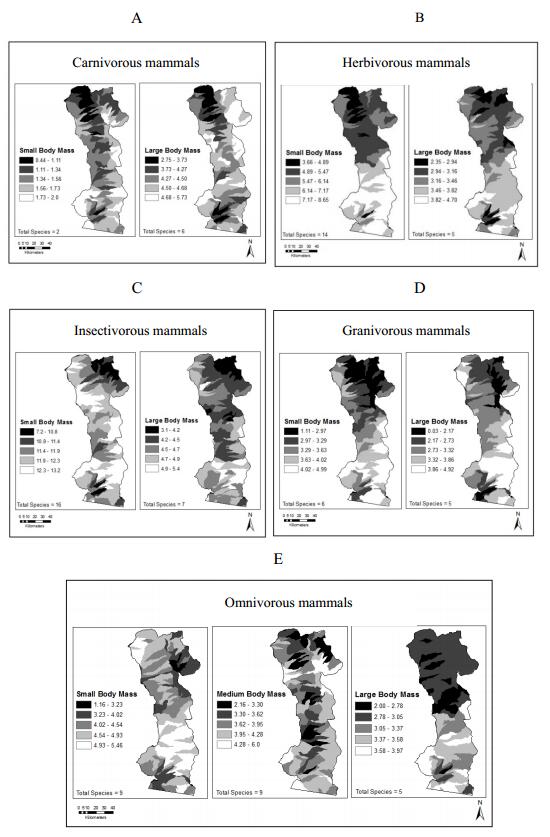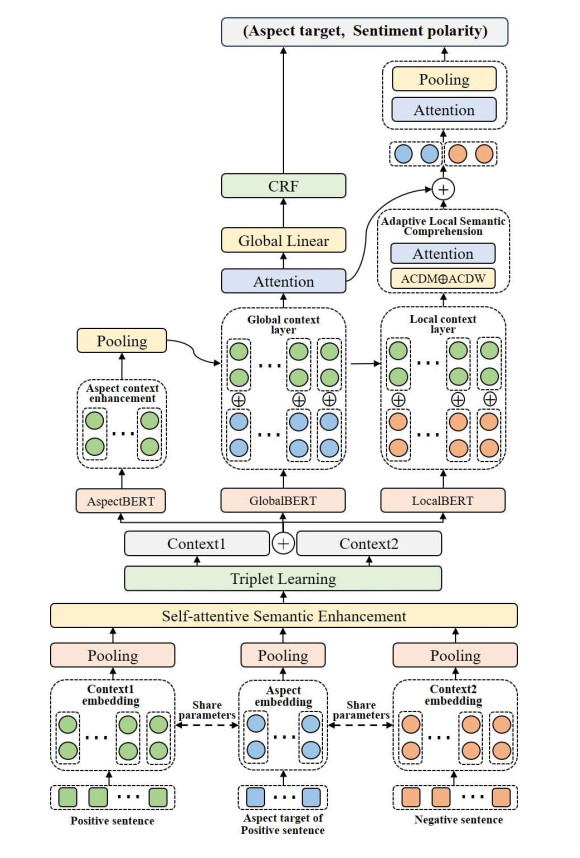1.
Introduction
Resilience and redundancy are important concepts for long-term conservation efforts as both strongly influence how an ecosystem adapts or responds to changes in the environment [1,2]. Holling [3] defined resilience as a system's capacity to withstand changes and absorb disturbances while still retaining the same relationships between populations or state variables. Redundancy occurs when a species fills the same ecological role as another species, such that if one species goes extinct, another will fill that same ecological niche [4].
Resilience and redundancy are linked because resilience determines the effects of changes in biological diversity, but these effects cannot be identified without understanding the effect of a decline in redundancy on an ecosystem [4]. Walker [5] suggested a positive relationship between ecological redundancy and ecosystem resilience. Understanding how changes in ecological redundancy are influenced by changes in functional groups, and how these changes in turn impact resilience allows for development of better conservation strategies and management plans [4]. The importance of these concepts has been discussed for a number of years; in fact the current understanding of the concepts of resilience and redundancy is really a reformulation of the diversity-stability hypothesis [6,7,8,9] in which the terms are carefully given operational definitions. Even with these operationalized terms, however, it can be difficult to quantitatively measure these indices spatially [1,10]. The ability to measure and map ecological resilience and redundancy is essential in times of rapid landscape and environmental change [11,12,13]. The concept of resilience implies that any ecosystem has a threshold amount and severity of disturbance it can withstand before shifting to an alternative, often less desirable state [14]. If an ecosystem's resilience is compromised, smaller or fewer disturbances may result in a change of state [14].
Ecosystems are complex systems with poorly-understood processes defining the arrangement of their components; one property of such systems is that their governing processes can generate discontinuities in the ecosystem's state variables [1,15]. Discontinuous body mass distributions of the species within an ecosystem are one common and readily-measured example of an ecosystem discontinuity [12,15]. These discontinuous body mass distributions have gaps in the distribution that mark the transition from one body mass scale to another [15]. Species occurring between each discontinuity represent a separate body mass group (BMG) [15]. The existence of these discontinuities influences the resilience of an ecosystem because the discontinuities reflect natural disturbances such as species invasions, extinctions, migration, and population variability [1].
Body mass categories have been used to identify animal functional groups in ecosystems [1,16]. Functional groups are defined as species sharing similar ecological characteristics, attributes, or roles; species within a functional group are likely to have similar effects on ecosystem structure and function (mediated by body mass, diet, foraging strategy, etc.) [1,4,16,17]. For example, the body mass of an organism may determine its ability to interact with the environment based upon the available resources in the ecosystem [15,18]. The concept of functional groups is based on the classic ecological concept of guilds [19].
The goal of this research was to develop and demonstrate a method to quantitatively measure resilience and redundancy in a spatially explicit manner within a local watershed with readily available data. We evaluated resilience and redundancy across functional groups assuming a higher number of species would exhibit greater resilience and redundancy. The resultant analysis in the San Pedro River Valley in southeastern Arizona provides land managers information on potential areas of high and low resiliency and redundancy to prioritize management focus.
2.
Materials and method
2.1. Study area
We conducted this study on the San Pedro Watershed (Figure 1). The Upper San Pedro River Basin flows from Sonora, Mexico north into Arizona [20,21,22]; however, analysis was completed only on the approximately 5,800 km2 of the San Pedro watershed occurring in the United States because of data availability [20,22]. This watershed is diverse, supporting a high number of mammal species and over 350 bird species, including many migratory species [23]. Elevation ranges from 900–2900 m with annual rainfall ranging from 30–75 cm [22]. The San Pedro has variable topography, climate, vegetation, and diverse biome types including desert scrub, grasslands, oak woodland-savannah, mesquite woodland, riparian forest, coniferous forest, and agriculture [20,22]. The southern part of the watershed is predominantly composed of semi-desert grasslands and Chihuahuan desert scrub. The northern and lower in elevation portion of the watershed is predominately Sonoran desert scrub and semi-desert grasslands land cover types [24,25].
2.2. Animal habitat models
Our spatial analyses used terrestrial vertebrate species habitat models from the Southwest Regional Gap Analysis Project (SWReGAP). These models show the predicted distribution of habitat for vertebrate species occurring in the five southwestern states (Arizona, Colorado, Nevada, New Mexico, and Utah) [26,27]. Models are available for vertebrate species that reside, breed or use the habitat in the Southwest region for a significant portion of their life history [26]. For the Southwest, there were 817 modeled vertebrate species, 452 of which are predicted to occur in the San Pedro Watershed. Models were deductive habitat models identifying the habitat associations of each species with land cover, elevation, distance to streams, springs and other water bodies, and soils. Models predicted suitable habitat where environmental correlates specific to the species were identified [26]. Body mass, diet, or both, were not available for some mammal and bird species; we excluded these species from our analyses. Amphibians and reptiles were excluded due to poor availability and reliability of body mass data.
2.3. Functional groups
We followed the methods outlined by Forys and Allen [16] and Allen et al. [1]. We divided the modeled species into functional groups, first based on taxon, then based on body mass, and lastly on diet. Mean body mass data were found in peer-reviewed literature, online datasets, and books [15,28,29,30,31]. Seven diet categories were identified for birds (carnivores, herbivores, omnivores, insectivores, granivores, nectarivores, and piscivores). Six diet categories were identified for mammals (carnivores, herbivores, omnivores, insectivores, granivores, and nectarivores)[32] identified small mammals as being mainly insectivores and granivores while large mammals are generally carnivores or herbivores. Diets were based on species information from NatureServe [30]. If multiple diets were recorded, the first diet listed was used.
2.4. Discontinuities
We used two methods to identify the body mass categories used to place species into functional groups. The first was based on identifying discontinuities in the body mass distributions. The discontinuities for birds and mammals were found using the Body Mass Difference Index (BMDI) as described by [15]:
Where Mn is the body mass of the nth species in order of increasing body mass and k is a constant that detrends the data (k = 1.3 for birds and 1.1 for mammals; [15]). To represent a discontinuity in the data, a criterion line was placed at the mean BMDI value plus one standard error. Values that exceeded the criterion line represent discontinuities [15]. The body mass difference index divided mammal and bird species of the San Pedro Watershed into four body mass groups (BMGs): small, small-medium, medium-large, and large (Figure 2).
2.5. Percentage of body mass
Our second method for identifying BMGs was based on percentages of the range of log10 of body mass. Category 1 percentage-based BMGs were divided into three equal percentages of the log10 of the body mass range. This resulted in three BMGs: small (0–33%), medium (>33–66%), and large (>66–100%) BMGs. Category 2 percentage-based BMGs were defined by dividing the range of the log10 of the species body mass range in half (small BMG < 50%; and large BMG ≥50%).
2.6. Resilience and redundancy
Functional groups created by the process described above were used to calculate resilience and redundancy. To determine resilience and redundancy, the procedures from Allen et al. [1] and Sundstrom et al. [2] were followed. Resilience was found by three different methods: 1) total number of diets within each BMG (Rs1), 2) total number of species within each BMG (Rs2), and 3) total number of species that use a certain diet among all BMG (Rs3) [2]. Redundancy was measured in two ways: 1) the number of species who utilize a diet within each BMG (Rd1) [1], and 2) the count of each diet across all BMGs (Rd2) [2].
2.7. Spatial analysis
For spatial analysis, functional groups were defined as above, based on a three-way classification by taxon, diet, and body mass. Only the percentage-based BMGs were used in the spatial analyses. If the Category 1 percentage-based BMGs resulted in four or fewer species in one BMG, then the Category 2 BMGs were used for that taxon/diet combination. We conducted spatial analysis using zonal statistics and neighborhood statistics to put findings in context of national level efforts such as the U.S. Environmental Protection Agency (EPA) EnviroAtlas [25,33]. Zonal statistics match the reporting unit used in the EnviroAtlas. Neighborhood statistics provide an analysis of scale for consideration into operationalizing the process at the national level on a pixel basis.
The SWReGAP's terrestrial vertebrate species habitat models were used to identify potential animal species habitat for the spatial analysis. All analyses were performed in ArcGIS version 10 (Environmental Systems Research Institute, 2011). The species habitat models were overlaid to create raster maps depicting the number of species per pixel for each functional group across the San Pedro Watershed. The map for each functional group was then analyzed using both zonal statistics and neighborhood (block) statistics.
Zonal statistics computed included mean, maximum, and standard deviations of species richness for each functional group based on the 12-digit Hydrologic Unit Codes in the watershed (United States Department of Agriculture, Natural Resources Conservation Service, 2009). Neighborhood statistics computed included mean, maximum, and standard deviations of species richness for each functional group within a 500 m2, 1 km2, and 5 km2 block in the watershed. Three different neighborhood values were used in order to evaluate the effects of neighborhood size on the results.
3.
Results
3.1. Resilience and redundancy
We first analyzed resilience and redundancy results for the discontinuity-based functional groups (Table 1). Among bird species, the small-medium BMG was the only group to have all seven diets represented (Rs1). The medium-large BMG had six of the seven diets represented (Rs1). The small-medium BMG contained 201 birds of the total 283 bird species (Rs2). Insectivores made up the highest total number of species with 154 of the 283 total bird species (Rs3). Carnivores and granivores had the second and third highest total number of species with 37 and 30 species respectively (Rs3). Most insectivores occurred in the small-medium BMG (RD1). As with the insectivores, the majority of granivorous species occurred in the small-medium BMG (RD1) with only one granivorous species occurring in the medium-large BMG. The majority of carnivore species occurred in the medium-large BMG (RD1). The small BMG had a total of five species, all of which were nectarivores (RD1). Insectivores, nectarivores, and granivores occurred in two of four BMGs (RD2). The remainder of the diets occurred in three of the four BMGs (RD2).
Among mammals (Table 1), the small BMG was the only group represented by all six diets (Rs1). In addition, the small BMG contained the most mammal species (55 out of a total of 85) (Rs2). Insectivores and omnivores had the highest total number of species, each with 23 species of the 85 total (Rs3). Herbivores had the third largest number of species with 19 (Rs3), and most occurred in the small BMG (RD1). Insectivores, nectarivores, and granivores occurred in one of four BMGs; while carnivores occurred in three of the four BMGs (RD2). Herbivores and omnivores occurred in all four body mass groups (RD2). All insectivore species occurred in the small BMG (RD1). The majority of omnivore species occurred in the small (9) and medium-large (7) BMG (RD1). As with the insectivores, all granivorous (11) and nectarivorous (1) mammal species occurred in the small body mass group (RD1).
We then analyzed resilience and redundancy results for the percent-based functional groups (Table 2). Among bird species, the small BMG in Category 2 was the only group to have all seven diets represented (Rs1). The small and medium BMGs in Category 1 and the large BMG in Category 2 all included six of the seven diets (Rs1). The small BMG for both Category 1 and Category 2 contained the most bird species, 134 and 195 respectively (Rs2). As with the redundancy results for the discontinuity-based functional groups, most of the 154 insectivore bird species occurred in the small BMG for each category, 100 and 143 species respectively (RD1). Similar to the results for discontinuity-based functional groups, the majority of granivorous bird species occurred in the small BMG (21 species in Category 1 and 26 species in Category 2) (RD1). The majority of carnivorous, herbivorous, and piscivorous species occurred in the large BMG for both Category 1 and Category 2 classifications (RD1). All nine nectarivorous species occurred in the small BMG for both Category 1 and Category 2 (RD1). However, nectarivores occurred only in one body mass group for both Category 1 and Category 2(RD2).
Among mammals (Table 2), the small BMG in both categories is the only group to have all six diets represented (Rs1). All other BMGs include three diets. Resiliency results show the small BMG for both categories contained the most mammal species (53 and 58 respectively) out of the total of 85 species (Rs2). As with the redundancy results for the discontinuity-based functional groups, all of the insectivorous mammal species occurred in the small BMG for both Category 1 and Category 2 (23 species) (RD1). All granivorous and nectarivorous mammal species occurred in the small BMG (RD1). The majority of carnivorous mammal species occurred in the large BMG for both Category 1 and Category 2 classifications. Herbivores and omnivores had a more even spread of species across BMGs for both Category and Category 2. Insectivores, nectarivores, and granivores only occurred in one BMG in both Category 1 and Category 2 (RD2).
3.2. Spatial analysis
3.2.1. Zonal statistics
We conducted spatial analysis using zonal statistics to match analysis to national level efforts such as the EPA's EnviroAtlas [25,33]. Analyses of zonal statistics for the San Pedro Watershed showed that the northern part of the San Pedro watershed had a lower mean number of species, or a lower redundancy (RD1) value, for most functional groups in (Figures 3–5). Bird functional groups generally had a lower mean number of species in the northwestern portion of the watershed. Carnivorous birds had lower means in the north-central and northwest portions of the watershed for the small BMG and the northeast for both medium and large BMGs (Figure 3). Herbivorous birds had lower means in the central and north portions of the watershed for the small BMG (Figure 4). However, low means were found over the entire watershed for the large BMG for herbivorous birds (Figure 4). Insectivorous birds had lower means in the northwest for all three BMGs (Figure 3). The small BMG for omnivorous birds had areas of low mean species, specifically in the central and eastern portions of the watershed (Figure 4). The large BMG for omnivorous birds had low mean numbers of species in the central and northwest portions of the watershed (Figure 4). The small and medium BMGs for granivorous birds had lower mean numbers in the northwest, but the large BMG had relatively high mean numbers of species over the entire study area (Figure 3). Nectarivorous birds had low mean values across the watershed for the small BMG and in the northwest for the large BMG (Figure 4). Piscivorous birds had low means across the entire watershed for both BMGs (Figure 4).
Zonal statistics for carnivorous mammals identified lower means or redundancy value (RD1) in the northwestern portion of the watershed for both small and large BMGs (Figure 6). Herbivorous mammals had lower species means in the central and northern portions of the watershed (Figure 5). Insectivorous mammals in both BMGs had lower species means in the northeast (Figure 5). Omnivorous mammals had lower means in the central and northern portions of the watershed for both the medium and large BMGs (Figure 5). Granivorous mammals had lower means for both BMGs in the northeastern portion of the watershed (Figure 5).
Zonal statistics for total bird species richness in the San Pedro Watershed indicated low mean numbers of species in the central to northwestern part of the watershed (Figure 7). Low mean mammal species richness was found in the northern and northeastern portions of the watershed. Zonal statistics for the total species richness (birds and mammals combined) presented a pattern similar to that found for bird species richness, with a lower mean number of species in the central and northwestern portions of the watershed. The southwestern portion of the watershed had low mean species richness for all groups (birds, mammals, and total species).
3.2.2. Neighborhood statistics
We conducted spatial analysis using neighborhood statistics to understand how the analysis might by operationalized at the national level on a pixel basis. Neighborhood statistical analysis examined redundancy measures across varying neighborhood (block) sizes (Table 3). For bird functional groups, the maximum values of redundancy (RD1), are the same between all neighborhood blocks except within the medium BMG for insectivorous birds, which has a higher maximum value of 43 species for the 5 km2 block size compared to the 500 m2 and 1 km2 block sizes, for which the maximum value was 40 species. Neighborhood statistical analysis for mammal functional groups shows the maximum number of species is the same across all block sizes.
4.
Discussion
Within the San Pedro Watershed, we found resilience and redundancy were similar between discontinuity-based and percentage-based functional groups for both taxa. Functional groups of species with smaller body masses had a larger number of species and diets compared to groups with larger body masses that had fewer species and diets. This suggests higher resilience and redundancy in the smaller body mass groups. These results are similar to findings of Skillen and Maurer [18] and Sundstrom et al., [2].
Groups of species with high redundancy within and across body mass groups increase the resilience of an ecosystem [11]. We found increased redundancy (RD2) for herbivore and omnivore mammals for discontinuity-based functional groups. Similarly, we found increased redundancy (RD2) for carnivore, herbivore, and omnivore mammal species using percentage-based functional groups. For birds, insectivores comprised the majority of species, indicating a higher resiliency (Rs3) for this diet group. In most instances, insectivore species made up a significant portion of the small BMGs for both taxa indicating higher redundancy (RD1). However, insectivorous mammals had lower redundancy (RD2) across BMGs as they only occur in the small BMG. Nectarivore species consisted entirely of hummingbirds and bats. These species show little redundancy as they generally only occurred in the small BMG. Also, there was only one species of nectarivorous mammal, which identified little resilience and redundancy for this functional group. Since insectivorous mammals and nectarivores have low resilience and redundancy, they are a group of species that may need to be monitored. Sundstrom et al., [2] found lower resilience to disturbances when there were two or fewer species in a given functional group. Walker [5] suggests that recognition of functional groups with reduced resiliency and redundancy is important in the conservation of the overall biodiversity of an ecosystem. Granivorous mammals had higher redundancy for the BMGs in which they are represented (RD1), but low redundancy across BMGs as they only occur in one BMG (RD2).
Zonal data analyses identified areas of lower mean species richness (lower redundancy) within the San Pedro Watershed. Overall, the central and northern part of the watershed had lower richness and lower redundancy. Areas of reduced redundancy relative to the remainder of the watershed may be at a higher risk of shifting to an alternative state after a disturbance. The northern and lower elevation part of the San Pedro Watershed is predominantly composed of desert scrub types, including mesquite upland scrub (low mammal species richness), Sonoran palo verde mixed cacti desert scrub (low richness for both taxa), and creosotebush, mixed desert and thorn scrub (low bird species richness)[24,25].
The San Pedro watershed is an important ecosystem for many species. Over 350 bird species use the watershed as habitat for either migration or nesting, and its mammalian species richness is among the highest in the world for similar-sized regions [23,34]. The watershed hosts higher biodiversity and related ecosystem services compared to the Southwest US as a whole [25]. Several species that use the San Pedro watershed are threatened or endangered, including the Mexican spotted owl (Strix occidentalis lucida), the Sonoran tiger salamander (Ambystoma tigrinum stebbinsi), and the lesser long-nosed bat (Leptonycteris yerbabuenae) [35]. Since the San Pedro watershed is such an integral part of the survival of many species, it is important to know how resilient it would be in the event of perturbations such as continued human development or climate change.
Body mass has been shown to be positively correlated with extinction risk [36]. This could be related to the generally K-selected life history traits of larger bodied species such as lower fecundity, fewer offspring, slow maturation, long lifespan, higher trophic levels, and greater habitat range requirements [36,37]. Within our analysis, these larger species were generally carnivores, omnivores and herbivores. Small bodied species are generally r-selected species that are able to mature early, reproduce rapidly, and produce a high number of offspring [37]. Within our analysis these smaller species were insectivores and granivores. The positions of species on the r-K continuum could influence the resilience and redundancy of an ecosystem.
In the face of gradual environmental changes, such as those occurring due to climate change, K-selected species are expected to have a high risk of extinction; however, r-selected species are at risk of extinction due to rapid environmental changes and extreme disturbance events [36]. K-selected species do well in stable environments and are resilient in the event of small disturbances, but will have less ability to recover in the event of a long-term disturbance because they reproduce slowly [36]. However, r-selected species are affected by small or short-term disturbances due to their population variability and often limited habitat range, but their higher reproduction capacity allows them to have higher resilience in the event of a long-term disturbance [36,37]. Ultimately there is a connection between the species as our larger bodied carnivores and omnivores likely prey on most of the smaller bodied insectivores and granivores.
Whether an individual species is a generalist or specialist may affect its niche in the resiliency and redundancy of an ecosystem. Generalist species are better able to adapt than specialist species [36]. However, a species may be a dietary generalist, but have a highly specialized foraging strategy, causing it to have decreased adaptability [37]. Functional attributes such as generalist/specialist diet, foraging strategy, and role in ecological function would enhance future efforts to elucidate the effect species changes have on the resilience and redundancy of an ecosystem. Considering foraging strategy may also clarify the role of a species or functional group in an ecosystem. Individual species demography and food web position also influence resilience and redundancy in an ecosystem. The population of individual species within the watershed is an important aspect to consider and correlated to not only to the functional role of the species buy also the extinction risk to the species. Additionally, metapopulation structure is also an important aspect that needs further study. However, these data were difficult to obtain for all 368 species used in this study. Gagic et al. [38] suggested a trait-based approach to link biodiversity and ecosystem functioning. A further step would be to test this approach in terms of redundancy and resilience.
Our method provides a coarse level assessment that can be conducted anywhere within the conterminous United States with national datasets provided by USGS Gap Analysis Project [39]. Though we focused on a watershed, other areas of interest could be used including ecoregion, landscape conservation cooperative, county, state or ultimately the entire nation. The analysis does not take into account the role of species populations which is an important consideration and is related to risk of extinction. Functional groups that have fewer species, such as nectarivores in our analysis, will be considered less resilient and redundant. We also have not accounted for the differences in r and K species or generalist and specialists. Incorporating these concepts are important future needs.
Comparisons across multiple scales are necessary in order to understand the resilience and redundancy of an ecosystem [16]. The arrangement of functional groups within and across spatial scales helps to determine the resilience of an ecosystem [11]. Peterson et al. [11] predicted that if multiple species in a functional group occupy different scales, they will increase the resilience of an ecological process which therefore increases the resilience of the system; furthermore, this niche separation minimizes competition among species within functional groups [11]. Analysis should be conducted on both watershed and regional scales for a more complete understanding of resilience and redundancy.
Resilience and redundancy will be important concepts in the conservation of biodiversity in the future [40]. Both properties have been thought to act as a buffer against change in an ecosystem [5]. Functional groups with increased resilience or redundancy can help to maintain the integrity of an ecosystem, making the system more robust. Changing the focus from individual species to functional groups and identifying the resilience and redundancy of an ecosystem will help to maintain and conserve the biodiversity of a system in the long-term [5].
This study supports the recent importance given to larger bodied carnivores in both taxa groups [41,42,43]. We identified the importance of small mammals within the ecosystem even though redundancy is in place. Our results also identify the biodiversity and ecosystem services aspects provided by birds and mammals. There is high insectivore redundancy supporting the concept that birds provide regulating services [44]. Our results also show the low nectarivore redundancy in the study area, and thus support the current focus on management of birds and particularly mammals that play a key role in these ecosystem processes [45,46,47].
5.
Conclusion
The methodology described here provides a coarse level measurement of resiliency and redundancy. This process should be considered as a first level effort in an iterative process in which subsequent efforts include more site specific data and multiple spatial scales. Using landscape scale models to assess the resilience and redundancy of an area is beneficial to land managers, agencies, and stakeholders as it allows a process to focus attention on potential areas of decreased resilience and redundancy. Specifically, in the San Pedro, the northern part of the watershed was found to have decreased resilience and redundancy for both birds and mammals, indicating this region may be an area where management practices or strategies will need to be implemented or reviewed. Attention should be focused on functional groups with low redundancy and resiliency in order to conserve the biodiversity of an ecosystem in the future [5]. Conservation of these groups will ensure the conservation of the ecosystem functional services they [5].
Since species with larger body masses typically show reduced resiliency and redundancy in the event of long-term disturbances [36], management efforts and strategies should focus on these species after a prolonged disturbance such as after multiple years of drought. Species with smaller body masses show lower resilience in the event of a short-term disturbance [36,37], so management efforts and strategies should focus on these species in the event of a short-term disturbance such as after a fire. Herpetofauna should be included in future research to help understand how these taxa affect the resilience and redundancy of an ecosystem.
Acknowledgments
This research was funded in part by the U.S. Environmental Protection Agency (EPA) Interagency Agreements (DW-14-95827201 and DW-14-95527201) administered by the Office of Research and Development (ORD) and the U.S. Geological Survey (USGS) Gap Analysis Program under Research Work Order (G14AC00104). We thank E.A. Samson, R.K. Guy, D.A. Kopp, N.F. East, K.J. Gergely, A.C. Neale, W.G. Kepner, and D.F. Bradford. Additional financial assistance was provided by the USGS New Mexico Cooperative Fish and Wildlife Research Unit and the New Mexico State University, Agricultural Experiment Station.
Conflict of interest
The authors declare no conflict of interest.
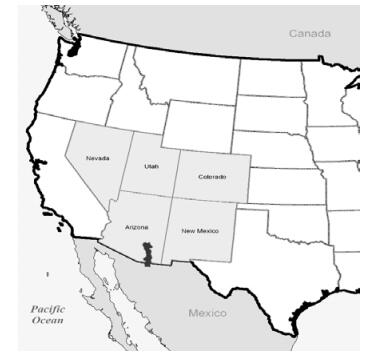









 DownLoad:
DownLoad:

